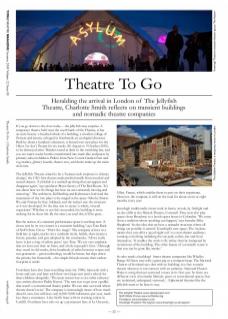If you go down to the river today… the Jellyfish may surprise. A temporary theatre built near the south bank of the Thames, it has an eerie beauty: a beached whale of a building; a wooden collage of flotsam and jetsam, salvaged in Southwark; an ecological dinosaur. Built by about a hundred volunteers, it housed two new plays for the Oikos (‘ee-kos’) Project for six weeks (26 August to 9 October 2010), to be destroyed after. Wander round at dusk to the twinkling bar, and you see water-cooler bottles transformed into mask-like sculptures by primary-school children. Pallets from New Covent Garden fruit and veg market, glittery boards, theatre sets, and desks make up the main structure.
The Jellyfish Theatre aimed to be a ‘human-scale response to climate change’, the UK’s first theatre made professionally from recycled and reused objects. ‘A jellyfish is a washed-up thing that can appear and disappear again,’ says producer Bryan Savery of The Red Room. ‘It’s not about how we fix things but how we are constantly moving and removing.’ The architects, Köbberling and Kaltwasser, had read the treatments of the two plays to be staged in the space Oikos by Simon Wu and Protozoa by Kay Adshead, and the writers saw the structure as it was developed. So the idea was to create ‘a whole, visceral experience’. Whether or not this succeeded, the building is more striking for its short life. By the time you read this, it’ll be gone...
But the notion of a transient performance space is nothing new. ‘A circus tent by its very nature is a transient building,’ says Tom Rack of NoFit State Circus. ‘That’s the magic.’ The company arrives in a field late at night, marks out a symbolic circle, builds, then creates a furore, parades, and gets adopted by the community. ‘All we really leave is just a ring of yellow grass,’ says Tom. ‘We are very emphatic that we leave just that: no litter, and a hole in people’s lives.’ Although they travel in old trucks, drive hundreds of miles between venues and run generators – green technology would be better, but slips down the priority list financially – the simple lifestyle means their carbon footprint is small.
Footsbarn have also been travelling since the 1980s, famously with a horse and cart, and later with their own large tent (and a school for their children alongside). ‘The main reason was to see other cultures,’ says artistic director Paddy Hayter. ‘The tent was to get near a public that wasn’t a conventional theatre public. We can take our work where theatre doesn’t exist.’ The company is increasingly aware of how much diesel it uses, but still does only 8,000-9,000 kilometres per year, much less than a commuter. Like NoFit State with its training centre in Cardiff, Footsbarn have also set up a permanent base at La Chaussée, Allier, France, which enables them to pass on their experience. However, the company is still on the road for about seven or eight months every year.
Kneehigh traditionally create work in barns, woods, by firelight and on the cliffs at the Minack Theatre, Cornwall. They now also play spaces from Broadway to a lavish opera house in Colombia. ‘We come from a tradition where anything can happen,’ says founder Mike Shepherd. ‘So the idea that we have a nomadic structure where all things are possible is central.’ Kneehigh’s new space, The Asylum, means they can offer a ‘good night out’ to a non-theatre audience, running everything including the car park, toilets, bar and food themselves. ‘It enables the work to fly rather than be hampered by restrictions of the building. The other beauty of a nomadic venue is that you can be gone like smoke.’
So who needs a building? Street theatre companies like Whalley Range All Stars tour with a giant pig or a compost heap. The National Theatre of Scotland says that with no building, it is free to make theatre wherever it can connect with an audience. National Theatre Wales is using thirteen scattered venues in its first year. So there are different sorts of nomadic lifestyle: green or conventional spaces that are reclaimed, redesigned, removed… Ephemeral theatres like the Jellyfish seem to be here to stay.
The Jellyfish Theatre www.oikosproject.com
NoFit State Circus www.nofitstate.org
Footsbarn www.footsbarn.com
Kneehigh Theatre’s The Asylum www.kneehigh.co.uk/asylum/

